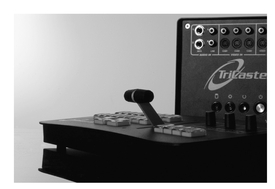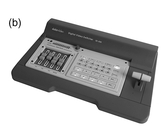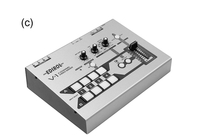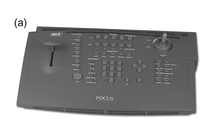14
Choosing a Video Switcher
Ed Driscoll

Figure 14-1
Finding the best video switcher that’ll go the distance.
Choosing a video switcher is a significant decision for most video producers. While a video project’s cinematography determines what it looks like, it’s the video switcher that gives a multiple camera shoot its overall professional sheen. Video switchers, also known as video mixers, are particularly essential for a live production. A talented operator can use a switcher to blend individual video cameras on the fly with dissolves, wipes, and other effects, and frequently—but not always, as we’ll discuss in a few moments—the sound as well. For a video director, the switcher is practically like a musical instrument, and shot timing and dissolves are often timed for an almost rhythmic feel that’s subliminal, but palpable. For someone new to this aspect of video production, the switcher’s myriad of knobs, faders, T-bars, inputs and outputs can appear overwhelming at first. But remember that what’s going on with one row, is usually the same with the other rows.
Swiss Army Knives Don't Always Make the Best Weapons
Although a few manufacturers might give you the impression that their switchers


Figure 14-2 Video switchers come in many shapes and sizes, so be sure to research your needs for special features before you buy.
can do everything, it’s always best to have some idea ahead of time the main type of production you’ll be using the unit for. Some units will be more flexible and allow you to work on different types of projects. Others are more limited, but may be perfectly suited for the type of production you make every week.
Are you going to use the switcher at a live performance on location? Then consider a model with its own custom-fitted travel case. Unless the switcher is going to be fitted into a studio control desk and never be transported, buying the case could be well worth the extra cost to protect the delicate circuitry inside. In addition, for those location jobs, you might want to consider, a unit like the Datavideo SE-800, which has its own optional small bank of attachable video monitors.
But if you’re working in a studio, then external monitors will give you a better idea what the audience is seeing, and small proprietary monitors become less important.
I/O Silver!
Of course, planning your input and output needs ahead of time is necessary. How many cameras will you need to switch? Are you mixing sound as well? All of these questions should be answered up front.
Most switchers will have a mixture of composite and S-video inputs. Many higher-end switchers will have bayonet-style BNC inputs. Whether these are worth the price depends again on your use: if you’re working in a high-traffic area, a BNC’s protection against accidental unplugging is worth the price.
Not all video switchers are set up for audio. Again, ask yourself where the work is going to be done. If you’re doing location work, a combined unit may make transport easier. A stand-alone audio mixer will probably have more features, and can provide somewhat better sound quality than combined units. If all-in-one sound and video is valuable to you, make sure the unit has a sufficient quantity of audio inputs and outputs for your needs.
High definition switchers are an even newer beast. Check out a switcher such as Edirol’s V-440HD if high def is definitely a high concept requirement.
Check for Effects
Effects are another big consideration. Generally, the greater the cost of the switcher, the greater the number of effects it has built-in, but this isn’t always true— with some switchers, you’re paying for durability, not a myriad of flashy effects. Typically, video switchers allow for chroma key effects, a variety of wipes and pattern dissolves, and the ability to do titles. Some mixers allow for a variety of chroma colors, others less so.
Some units feature a beats per minute (or “BPM” as all the cool hip-hop guys like to say) display to allow VJs in clubs to sync-up transitions and effects to the beat of the music that’s playing. Others also include a MIDI-input, allowing the switcher’s effects to be remote-controlled using MIDI (Musical Instrument Digital Interface), which happens to be the common language of electronic musical instruments.
Lower-end machines often lack chroma key, but typically have luminance control for inserting simple titles into a project. These types of low-end mixers also may lack preview outs. But since they typically offer very simple effects, there’s little need to preview.
The Focus Enhancements MX-4 is a well-equipped mid-priced switcher capable of producing a host of video effects. An audio mixing feature is also present. In combination audio-video mixers, listen for good audio sync. The MX-4 also includes a T-bar control, which, as we’ll discuss in a moment, may be an important feature for you.
The T-Bar Debate
Finally, what many consider to be an important control feature will require some thought. First of all, T-bars are infamous for being bumped if the switcher is in a crowded area. The bar protrudes in such a way that can be caught on a pants pocket or coat sleeve. A good rule of thumb is to not have any two “bars” together; keep the T-bar away from the martini bar.
Some users, especially when they are doing VJ-style productions, prefer the quicker response of a fader, as opposed to the slow, but more precise feel of a T-bar. In any case, the pacing of an event may determine your choice. Again, it helps to know what types of material the switcher will primarily be used for. Numark’s AVM01 streets for less than $1,000, and lacks a T-bar, but is an extremely popular switcher with the VJ set.
So, how to best assimilate this information? You’ll benefit the most by knowing your own projects, but leave yourself some room for expansion. See what others are using, and for what purposes. Don’t forget to consider the environment in which you’ll use it; indoor, outdoor, studio, or travel. Think of wear and tear if you have to set up and tear down often or don’t have a dedicated control room. A fair amount of decision-making will go into your purchase, but it’ll pay off with a switcher built for your needs.

